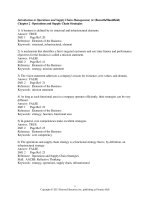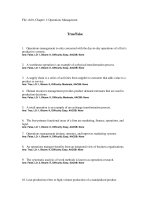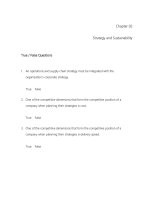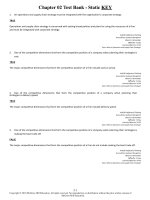Introduction to operations and supply chain management 3e bozarth chapter 11
Bạn đang xem bản rút gọn của tài liệu. Xem và tải ngay bản đầy đủ của tài liệu tại đây (1.21 MB, 44 trang )
Managing Inventory throughout
the Supply Chain
Chapter 11
Chapter Objectives
Be able to:
Describe the various roles of inventory, including the different types of inventory and
inventory drivers.
Distinguish between independent demand and dependent demand inventory.
Calculate the restocking level for a periodic review system.
Calculate the economic order quantity (EOQ) and reorder point (ROP) for a continuous
review system.
Determine the best order quantity when volume discounts are available.
Calculate the target service level and target stocking point for a single-period inventory
system.
Describe how inventory decisions affect other areas of the supply chain. In particular,
describe the bullwhip effect, inventory positioning issues, and the impacts of
transportation, packaging, and material handling considerations.
Copyright © 2013 Pearson Education, Inc. publishing as Prentice Hall
11 - 2
Inventory Management
Inventory – Those stocks or items used to
support production (raw materials and workin-process items), supporting activities
(maintenance, repair, and operating supplies)
and customer service (finished goods and
spare parts).
© 2010 APICS Dictionary
Copyright © 2013 Pearson Education, Inc. publishing as Prentice Hall
11 - 3
Inventory Types
Cycle stock
Safety stock
Anticipation inventory
Hedge inventory
Transportation inventory
Smoothing inventory
Copyright © 2013 Pearson Education, Inc. publishing as Prentice Hall
11 - 4
Types of Inventory
Cycle stock – Components or products that are
received in bulk by a downstream partner, gradually
used up, and then replenished again in bulk by an
upstream partner.
Safety stock – Extra inventory that a company holds
to protect itself against uncertainties in either
demand or replenishment time.
Copyright © 2013 Pearson Education, Inc. publishing as Prentice Hall
11 - 5
Types of Inventory
Anticipation inventory – Inventory that is held in
anticipation of customer demand.
Hedge inventory – A form of inventory buildup to
buffer against some event that may not happen.
© 2010 APICS Dictionary
Copyright © 2013 Pearson Education, Inc. publishing as Prentice Hall
11 - 6
Types of Inventory
Transportation inventory – Inventory that is moving
from one link in the supply chain to another.
Smoothing inventory – Inventory that is used to
smooth out differences between upstream
production levels and downstream demand.
Copyright © 2013 Pearson Education, Inc. publishing as Prentice Hall
11 - 7
Inventory Drivers
Inventory drivers – Business conditions that
force companies to hold inventory.
Table 11.2
Copyright © 2013 Pearson Education, Inc. publishing as Prentice Hall
11 - 8
Independent vs. Dependent
Demand Inventory
Independent demand inventory – Inventory
items whose demand levels are beyond a
company’s complete control.
Dependent demand inventory – Inventory
items whose demand levels are tied directly
to a company’s planned production of
another item.
Copyright © 2013 Pearson Education, Inc. publishing as Prentice Hall
11 - 9
Independent vs. Dependent
Demand Inventory
Example:
Independent demand:
• Kitchen table – Need 500 tables five weeks from now
Dependent demand:
• Kitchen table legs – Need 4 per table or 2,000 legs
• Calculation of dependent demand (Chapter 12)
Copyright © 2013 Pearson Education, Inc. publishing as Prentice Hall
11 - 10
Inventory Control Systems
Periodic Review System – An inventory system that
is used to manage independent demand inventory
where the inventory level for an item is checked at
regular intervals and restocked to some
predetermined level.
Continuous Review System – An inventory system
used to manage independent demand inventory
where the inventory level for an item is constantly
monitored and when the reorder point is reached,
an order is released.
Copyright © 2013 Pearson Education, Inc. publishing as Prentice Hall
11 - 11
Periodic Review System
Calculating the order quantity (Q)
Q = R-I
where
R = restocking level
I = inventory level at the time of review.
Figure 11.6
Copyright © 2013 Pearson Education, Inc. publishing as Prentice Hall
11 - 12
Periodic Review System
Calculating the restocking level (R)
Copyright © 2013 Pearson Education, Inc. publishing as Prentice Hall
11 - 13
Calculating Service Level
Service Level – A term used to indicate the amount
of demand to be met under conditions of demand
and supply uncertainty.
Assumes that the demand during the reorder
period and the order lead time is normally
distributed.
Copyright © 2013 Pearson Education, Inc. publishing as Prentice Hall
11 - 14
Continuous Review System
Key features:
Inventory levels are monitored constantly, and a
replenishment order is issued only when the reorder point
is reached.
The size of a replenishment order is typically based on the
trade-off between holding costs and ordering costs.
The reorder point is based on both demand and supply
considerations, as well as on how much safety stock
managers want to hold.
Copyright © 2013 Pearson Education, Inc. publishing as Prentice Hall
11 - 15
Continuous Review System
Assumptions:
Constant demand and lead time
Holding and Ordering cost known and fixed
Price of each unit is fixed.
Copyright © 2013 Pearson Education, Inc. publishing as Prentice Hall
11 - 16
Continuous Review System
When the demand rate and lead time are constant:
Reorder point = demand x lead time
R = dL
Figure 11.7
Copyright © 2013 Pearson Education, Inc. publishing as Prentice Hall
11 - 17
Economic Order Quantity
Economic Order Quantity (EOQ) – The order
quantity that minimizes annual holding and
ordering costs for an item.
Holding costs (H)– The cost to hold a single unit in
inventory for a year.
Ordering costs (S) – The cost of placing an order regardless
of the order quantity.
Copyright © 2013 Pearson Education, Inc. publishing as Prentice Hall
11 - 18
Total Yearly Inventory Costs
Total holding and ordering costs for the year
= Total yearly holding cost + Total yearly ordering cost =
Yearly holding cost = average inventory x holding cost
Yearly ordering cost = number of orders per year x fixed ordering cost
Copyright © 2013 Pearson Education, Inc. publishing as Prentice Hall
11 - 19
Comparing Ordering Costs to EOQ
Figure 11.9
Copyright © 2013 Pearson Education, Inc. publishing as Prentice Hall
11 - 20
Example 11.2
Annual demand (D) = 4,000
Annual holding cost (H) = $15
Ordering cost (S) = $50/order
Order quantity (Q) = 1,000 fans
Copyright © 2013 Pearson Education, Inc. publishing as Prentice Hall
11 - 21
Example 11.2
Calculate the EOQ and use that value as the order
quantity to see if the cost is lower and calculate the
total yearly inventory cost.
Cost Savings:
Copyright © 2013 Pearson Education, Inc. publishing as Prentice Hall
11 - 22
Reorder Points and Safety Stock
When demand rate (d) and lead time (L) are
constant:
When demand rate (d) and lead time (L) or
both varies:
Copyright © 2013 Pearson Education, Inc. publishing as Prentice Hall
11 - 23
The impact of varying
demand rates and lead time
Figure 11.10
Copyright © 2013 Pearson Education, Inc. publishing as Prentice Hall
11 - 24
Causes of Variability
The variability of demand
The variability of lead time
The average length of lead time
The desired service level
Copyright © 2013 Pearson Education, Inc. publishing as Prentice Hall
11 - 25









